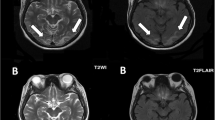Abstract
Chlorambucil (CHL) was used in combination with prednisolone in the treatment of nine children with frequently relapsing nephrotic syndrome. Serial electroencephalograms were obtained to evaluated CHL central nervous toxicity, before, during and after treatment with this agent. EEG abnormalities were observed in two of the nine children during chlorambucil therapy. EEG changes were diffuse spike and wave complexes and disappeared after discontinuation of therapy. There were no other neurological abnormalities and more particularly, no seizures or myocloni were observed. According to the literature, chlorambucil central nervous toxicity is found almost exclusively in childhood nephrotic syndrome. Strict neurological supervision of patients treated with chlorambucil is recomended.
Similar content being viewed by others
Abbreviations
- NS:
-
nephrotic syndrome
- CHL:
-
chlorambucil
References
Ammenti A, Reitter B, Muller-Wiefel DE (1980) Chlorambucil neurotoxicity: report of two cases. Helv Paediatr Acta 35:281–287
Baluarte HJ, Gruskin AB (1978) Chlorambucil dosage in frequently relapsing nephrotic syndrome: A controlled clinical trial. J Pediatr 92:295–298
Byrne TN Jr, Moseley TAE, Finer MA (1981) Myoclonic seizures following chlorambucil overdose. Ann Neurol 9:191–194
Green AA, Naiman JC (1968) Chlorambucil poisoning. Am J Dis Child 116: 190–191
Grupe WE, Makker SP, Ingelfinger JR (1976) Chlorambucil treatment of frequently relapsing nephrotic syndrome. N Engl J Med 295:746–749
Lion P, Testa GF, Semerano A (1970) Periodic myoclonic epilepsy in the kitten; an experimental study on the reactivity of the immature brain. Electroencephalogr Clin Neurophysiol 28:213
McLean A, Woods RL, Catovsky D, Farmer P (1979) Pharmacokinetics and metabolism of chlorambucil in patients with malignant disease. Cancer Treat Rev 6 (Suppl) 33
Mirsky AF, Block-Rojas S, McNary WF (1966) Experimental “petit mal” epilepsy produced with chlorambucil. Acta Biol Exp (Warsaw) 26:55–68
Naysmith A, Robson RH (1979) Focal fits during chlorambucil therapy. Postgrad Med J 55:806–807
Pascual JF, Molina M, Lopez J (1981) Long-term assessment of chlorambucil in children with nephrotic syndrome who fail to respond adequately to corticosteroids. Contrib Nephrol 27:65–74
Pinel JPJ, Chorover SL (1972) Inhibition by arousal of epilepsy induced by chlorambucil in rats. Nature 236:232–234
Pradhan SN, Marsan CA (1963) Chlorambucil toxicity and EEG “Centrencephalic” patterns. Epilepsia 4:1–14
Williams SA, Makker SP, Grupe WE (1978) A significant side effect of chlorambucil therapy in children. J Pediatr 93: 516–518
Williams SA, Makker SA, Ingelfinger JR, Grupe WE (1980) Long-term evaluation of chlorambucil plus prednisone in the idiopathic nephrotic syndrome of childhood. N Engl J Med 302:929–933
Wolfson S, Olney MB (1957) Accidental ingestion of a toxic dose of chlorambucil. JAMA 165:239–240
Author information
Authors and Affiliations
Rights and permissions
About this article
Cite this article
Ichida, F., Konishi, T., Asada, R. et al. Chlorambucil central nervous toxicity: a significant side effect of chlorambucil therapy in childhood nephrotic syndrome. Eur J Pediatr 144, 283–286 (1985). https://doi.org/10.1007/BF00451963
Received:
Accepted:
Issue Date:
DOI: https://doi.org/10.1007/BF00451963




